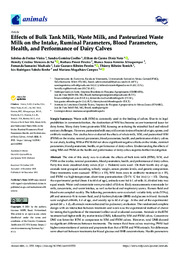Effects of bulk tank milk, waste milk, and pasteurized waste milk on the intake, ruminal parameters, blood parameters, health, and performance of dairy calves.
Effects of bulk tank milk, waste milk, and pasteurized waste milk on the intake, ruminal parameters, blood parameters, health, and performance of dairy calves.
Author(s): VIEIRA, S. de F.; COELHO, S. G.; DINIZ NETO, H.; SÁ, H. C. M. de; PEREIRA, B. P.; ALBUQUERQUE, B. S. F.; MACHADO, F. S.; PEREIRA, L. G. R.; TOMICH, T. R.; RENHE, I. R. T.; CAMPOS, M. M.
Summary: The aim of this study was to evaluate the effects of bulk tank milk (BTM), WM, and PWM on the intake, ruminal parameters, blood parameters, health, and performance of dairy calves. Forty-five male crossbred dairy calves (Gyr × Holstein) were used. On their fourth day of age, animals were grouped according to body weight, serum protein levels, and genetic composition. Three treatments were assessed: BTM (n = 15), WM from cows in antibiotic treatment (n = 15), and PWM via high-temperature, short-time pasteurization (72?74 ◦C for 16 s) (n = 15). During the experimental period (from 4 to 60 d of age), animals were fed 6 L of milk/d, divided into two equal meals. Water and concentrate were provided ad libitum. Daily measurements were made for milk, concentrate, and water intakes, as well as for fecal and respiratory scores. Rumen fluid and blood were sampled weekly. The following parameters were evaluated: volatile fatty acids (VFAs), pH and ammonia-N in rumen fluid, and β-hydroxybutyrate (BHB) and glucose in blood. Animals were weighed at birth, 4 d of age, and weekly up to 60 d of age. At the end of the experimental period (60 ± 1 d), all animals were euthanized for pulmonary evaluation. The randomized complete design with an interaction between treatment and week was the experimental method of choice for testing the hypothesis of the treatment?s effect on all evaluated outcomes. Animals in the BTM treatment had higher milk dry matter intake (DMI), followed by WM and PWM calves. Concentrate DMI was lower for BTM in comparison to WM and PWM calves. However, total DMI showed no significant differences between treatments. The rumen fluid from calves receiving PWM had higher concentrations of acetate and propionate than that of BTM and WM animals. No differences were observed between treatments for blood glucose and BHB concentrations. Health parameters (fecal and respiratory scores) and pneumonia occurrence showed no significant difference between treatments. No differences were observed for average daily gain (ADG) or body growth. Feeding WM and PWM did not show significant negative effects on the intake, ruminal parameters, blood parameters, health, or performance of dairy calves.
Publication year: 2021
Types of publication: Journal article
Unit: Embrapa Dairy Cattle
Keywords: Gado Leiteiro, Ganho de Peso, Pasteurização, Ácido Graxo
Observation
Some of Embrapa's publications are published as ePub files. To read them, use or download one of the following free software options to your computer or mobile device. Android: Google Play Books; IOS: iBooks; Windows and Linux: Calibre.
Access other publications
Access the Agricultural Research Database (BDPA) to consult Embrapa's full library collection and records.
Visit Embrapa Bookstore to purchase books and other publications sold by Embrapa.

